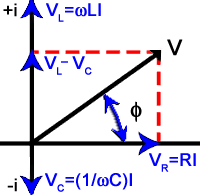1.4 Graphical Representation
From the above analysis (equations 1.2.7 and 1.2.10) we know that the voltage across the resistor (VR) is in-phase with I through the circuit. The voltage measured across the inductor (VL) leads the current by T/4 or π/2 radians (90°) and across the capacitor the voltage VC lags the current by T/4 or -π/2 (-90°). The appropriate vector plots are shown beneath each circuit element in Figure 1.6 below. The reference current, I is constant in magnitude and in-phase across each circuit element, so it's plotted along the x-axis (the real axis).
 |
| Figure 1.6. Vector diagrams of current and voltage relations across series RLC circuit elements. |
The complex representation of equation 1.2.10 above is
| V = RI + i ωLI + (-i/ωC) I | (1.4.1) |
This relation can be written in the same form as Ohm's law (equation 1.2.2) yielding
| V = Z I | (1.4.2) |
where Z is the complex impedance. Z is the complex sum of the impedances of the separate circuit elements. The impedance of the resistor is R; the magnitudes of the impedances of L and C are the inductive reactance (ωL) and capacitive reactance (1/ωC), respectively.
The vector plot of the various voltages is presented in the Figure 1.7.
 |
| Figure 1.7. Combined vector plot of voltage relations across series RLC circuit elements. |
Various relations for this figure are: V leads VR by φ. VR leads VC by π/2. VC lags VL by π.
The vector plot of the impedances is shown in Figure 1.8.
 |
| Figure 1.8. Combined vector plot of impedance relations for RLC circuit elements. |
Quantities plotted on the real axis are called real
or in-phase components. Quantities plotted on the imaginary
axis are called imaginary, quadrature, or out-of-phase components.
The phases in voltage and current are all temporal or time phases.
For example, V leads VR by (φ/2π)T
seconds (s), and VR leads VC by (![]() )T
= (T/4) s.
)T
= (T/4) s.
